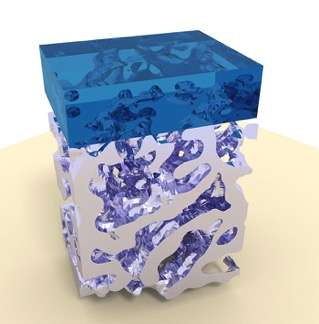Disordered nanonetwork produces robust and vibrant colors for vehicles, biomimetic tissues and camouflage

A peacock's bright teal and brilliant blue feathers are not the result of pigments but rather nanoscale networks that reflect specific wavelengths of light. This so-called structural coloration has long interested researchers and engineers because of its durability and potential for application in solar arrays, biomimetic tissues and adaptive camouflage. But today's techniques to integrate structural color into materials are time-consuming and costly.
Now, researchers at the Harvard John A. Paulson School of Engineering and Applied Sciences (SEAS), in collaboration with King Abdullah University of Science and Technology, have developed a new, more robust and cost effective system to build large-scale metamaterials with structural color. The research is described in the journal Nature Light: Science and Applications.
A peacock's feather or butterfly's wing rely on photonic crystals or highly ordered arrays of nanofibers to produce colors. Reproducing those structures in a lab requires precision and expensive fabrication. SEAS researchers were inspired by a very different kind of feather.
Contingas are one of the most flamboyant bird families on the planet. In a sea of Amazon green, their feathers pop with electric blues, bright oranges and vibrant purples.
Unlike a peacock's ordered array of nanostructures, contingas get their vibrant hues from a disordered and porous nanonetwork of keratin that looks like a sponge or piece of coral. When light strikes the feather, the porous keratin pattern causes red and yellow wavelengths to cancel each other out, while blue wavelengths of light amplify one another.
"Usually, we associate the idea of disorder with the notion that something is uncontrollable," said Federico Capasso, Robert L. Wallace Professor of Applied Physics and Vinton Hayes Senior Research Fellow in Electrical Engineering at SEAS and senior of author of the paper. "Here disorder can be put to our advantage and used as a design parameter to create a new class of metamaterials with a wide range of funcitionalities and applications"
Inspired by the cotinga feather, the researchers used a simple etching process to create a complex but random porous nanonetwork in a metallic alloy. The structure was then coated with an ultra-thin transparent alumina layer.
You may be thinking, what kinds of colors can a metallic alloy produce other than gray? As it turns out, lots. Ever since 19th century English scientist Michael Faraday, scientists have known that metals contain a plethora of colors but light doesn't penetrate deep enough to reveal them. A gold particle, for example, depending on its size and shape, can be red, pink or even blue.

The porous nanostructure creates localized hotspots of different colors in the alloy. The color that is reflected by the localized states depends on the thickness of the transparent coating.
With no alumina overlayer the material looks dark . With a coating 33-nanometers thick, the material reflects blue light. At 45 nanometers, the material turns red and with a coating 53 nanometers thick, the material is yellow. By changing the thickness of the coating, the researchers could create a gradient of colors.
"This situation is equivalent to a material with an extremely large number of microscopic and colorful sources of light," said Andrea Fratalocchi, corresponding author of the paper and Professor of Electrical Engineering; Applied Mathematics and Computational Science at the King Abdullah University of Science and Technology. "The presence of a thin layer of oxide can control the intensity of these sources, collectively switching them on and off according to the thickness of the oxide layer. This research shows of how disordered materials can be turned into an extremely powerful technology, which can enable large scale applications that would be impossible with conventional media."

The metasurface is extremely lightweight and scratch-proof and could be used in large-scale commercial applications such as lightweight coatings for the automotive sector, biomimetic tissues and camouflage
"This is a completely new way to control optical responses in metamaterials," said Henning Galinski, co-first author of the paper and former postdoctoral fellow in the Capasso group. "We now have a way to engineer metamaterials in very small regions, which previously were too small for conventional lithography. This system paves the way for large-scale and extremely robust metamaterials that interact with light in really interesting ways."
More information: aap.nature-lsa.cn:8080/cms/acc … s/AAP-lsa2016233.pdf
Provided by Harvard University



















